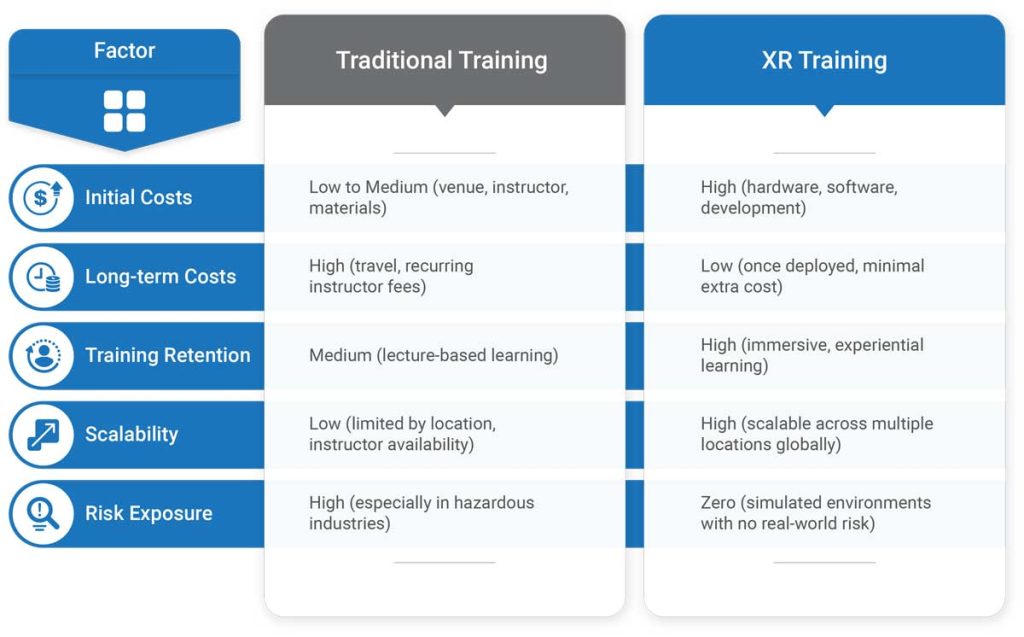In the ever-evolving world of workplace training, businesses are constantly seeking the best ways to upskill their teams—quickly, effectively, and without breaking the bank. Traditionally, this has meant classroom-style lessons, hands-on workshops, and the occasional video tutorial. But with the rise of XR technologies, we’re entering an era where virtual, augmented, and mixed reality could be the new classroom.
So, which approach provides the best return on investment? Let’s take a detailed look at the cost-benefit analysis of XR training versus the good old fashioned traditional training methods to help you make an informed business decision.
Traditional Training Methods: A Quick Overview
Picture this: a group of employees in a room, a trainer up front with a PowerPoint, and a lot of nodding heads (some of which may be nodding off). Traditional training methods, like classroom sessions or hands-on workshops, have been the bread and butter of workplace learning for decades. They’re familiar, they get the job done, but they come with challenges:
- Costs: Renting physical space, paying instructors, travel expenses (especially if you’re flying in team members), and material production all add up.
- Time Consumption: Coordinating schedules, travel, and event space for multi-day trainings can take a lot of planning and time.
- Limited Retention: Studies show that only a small percentage of information from lectures sticks after just a few days.
In a nutshell, traditional training is like buying a fast-food meal—it’s convenient but maybe not the best long-term investment.
XR Training Methods: Enter the Virtual Era
Now, imagine putting on a VR headset and being transported to a simulated factory where you can operate heavy machinery without fear of losing a finger. That’s XR training—offering immersive, interactive environments that feel real but come with zero risk.
At VR Vision, we’ve helped companies like Toyota and Coca-Cola adopt XR to train their employees in realistic, risk-free environments. Whether it’s learning how to operate complex equipment or practicing hazardous tasks, XR gives employees a hands-on experience without the real-world dangers.
Here’s why it’s worth considering:
- Reduced Long-term Costs: After the initial investment in hardware and software (which can seem a little steep at first), XR training slashes costs by eliminating the need for physical spaces, instructors, and travel expenses.
- Increased Learning Retention: Studies show that learners retain 75% more when they’re actively engaged in an immersive environment. That’s a huge jump from traditional training methods!
- Scalability: Once an XR training module is developed, it can be used for thousands of employees with minimal additional cost. Try doing that with a conference room and a whiteboard.
Let’s Talk Dollars and Cents
Now that we’ve covered the basics, let’s break it down further with a side-by-side comparison of costs.

A breakdown cost comparison of traditional training vs. XR training
While XR training has a higher initial cost (those VR headsets and custom-built simulations aren’t free), the ROI becomes evident in the long term. Think of it like buying a top-of-the-line espresso machine—it’s a bit pricey upfront, but you’ll save loads compared to buying your daily latte.
Benefits That Go Beyond Cost
Cost aside, let’s talk benefits. XR training doesn’t just save money; it also enhances performance, engagement, and flexibility.
- Better Prepared Employees: By training in realistic, interactive simulations, employees gain real-world experience. This is particularly useful in high-risk industries like construction or energy, where mistakes in training could lead to costly accidents or even employee injuries.
- Global Accessibility: XR can be deployed anywhere. No need for employees to travel across the country for a week-long training session—they can pop on a headset and dive into their lesson from home.
- Instant Feedback: XR training modules provide immediate feedback to learners, helping them adjust their actions and improve quickly. It’s like having a personal trainer in your pocket (or, in this case, your headset).
Examples of Success
At VR Vision, we’ve seen firsthand how companies benefit from XR training. When we worked with Toronto Hydro, we developed immersive simulations or digital twins that allowed their technicians to practice dangerous tasks in a virtual environment before attempting them in real life. Not only did this reduce accidents, but it also cut training times significantly. Our Vision Portal has helped clients like Avangrid roll out a plethora of VR training modules for various tasks across their workforce, streamlining the entire process and saving time and resources.
Conclusion: The Verdict
So, is XR training worth the investment? If you’re looking for long-term gains, improved learning retention, and the ability to scale training globally, the answer is a resounding yes. Traditional training methods still have their place, but XR opens up a world of possibilities that can transform how your workforce learns and performs.
In the end, it’s about what’s best for your team—and your bottom line. If you’re ready to explore XR training further, let’s talk! We’ve got some great case studies to share, and who knows, maybe even a virtual coffee. (We can’t train baristas yet, but we’re working on it.)
Want to see XR in action? Contact us today or check out our YouTube channel for real-life examples of VR training: VR Vision YouTube.